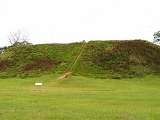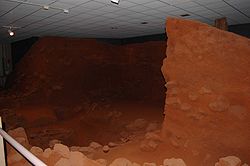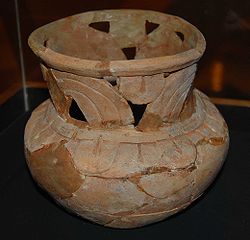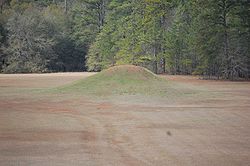
Kolomoki Mounds Historic Park
Encyclopedia
The Kolomoki Mounds are the largest and oldest Woodland period
mound complex in the Southeastern United States and currently stand in present day Early County
, Georgia
, near the Chattahoochee River
. The mounds were named a National Historic Landmark
in 1964. Seven of the eight mounds are protected as part of Kolomoki Mounds State Historic Park.

Kolomoki Mounds State Historic Park is an important archaeological site
as well as a scenic recreational area. Kolomoki, covering some three hundred acres, is one of the larger preserved mound sites in the USA. Hundreds of years ago, Kolomoki, with its surrounding villages, burial mounds, and ceremonial plaza, was a center of population and activity in North America. The eight visible mounds of earth in the park were built between 250-950 CE by peoples of the Swift Creek
and Weeden Island culture
s. These mounds include Georgia's oldest great temple mound
, two burial mounds and four smaller ceremonial mounds. The park's museum is built with part of an excavated mound inside, providing an unusual setting for viewing artifacts and a film about how the mound was built and excavated. Astronomical alignments have been noted for several mounds at the Kolomoki site. Mounds A, D, and E which form the central axis of the site form an alignment with the sun at the spring equinox. Mounds F and D form an alignment with the sun at the summer solstice.
Mound D was formed in several stages, each time increasing in size. It began as a square-platform mound that was about 6 feet (1.8 m) tall. This original platform mound was built from yellow clay. Sixty pottery
vessels were placed on the east wall including the above effigy pottery. The mound evolved into a larger circular mound about 10 feet (3 m) tall after many subsequent burials here and the addition of even more yellow clay. These burials took place on the eastern side of the mound, and skulls face eastward. Burial objects
made from iron and copper and even pearl beads were included in the aforementioned burials. Finally, the entire mound was covered with red clay.

 One night in March 1974, someone slipped into the old museum at the park and stole more than 129 ancient pots and effigies, numerous arrowheads and other treasures. Every artifact on display was stolen. Several years later, many of the pieces were recovered from Miami and St. Augustine, Florida. However, more than 70 relics are still missing, and the Georgia Department of Natural Resources
One night in March 1974, someone slipped into the old museum at the park and stole more than 129 ancient pots and effigies, numerous arrowheads and other treasures. Every artifact on display was stolen. Several years later, many of the pieces were recovered from Miami and St. Augustine, Florida. However, more than 70 relics are still missing, and the Georgia Department of Natural Resources
(DNR) is seeking public help in recovering these artifacts. Archeologists believe the pots are somewhere in Georgia or Florida.
"These pieces are an important part of North American history and should be properly protected for future generations to study", said Park Manager Matt Bruner. "They have significant meaning to the Native American people because many were used during burial ceremonies, plus they represent some of the finest craftsmanship of the Kolomoki culture". He emphasized that the state is more interested in recovering the pots than prosecuting the people who have them.
Woodland period
The Woodland period of North American pre-Columbian cultures was from roughly 1000 BCE to 1000 CE in the eastern part of North America. The term "Woodland Period" was introduced in the 1930s as a generic header for prehistoric sites falling between the Archaic hunter-gatherers and the...
mound complex in the Southeastern United States and currently stand in present day Early County
Early County, Georgia
Early County is a county located in the U.S. state of Georgia. It was created on December 15, 1818 and was named for Peter Early. As of 2010, the population is 11,008. The county seat is Blakely.-Geography:...
, Georgia
Georgia (U.S. state)
Georgia is a state located in the southeastern United States. It was established in 1732, the last of the original Thirteen Colonies. The state is named after King George II of Great Britain. Georgia was the fourth state to ratify the United States Constitution, on January 2, 1788...
, near the Chattahoochee River
Chattahoochee River
The Chattahoochee River flows through or along the borders of the U.S. states of Georgia, Alabama, and Florida. It is a tributary of the Apalachicola River, a relatively short river formed by the confluence of the Chattahoochee and Flint Rivers and emptying into Apalachicola Bay in the Gulf of...
. The mounds were named a National Historic Landmark
National Historic Landmark
A National Historic Landmark is a building, site, structure, object, or district, that is officially recognized by the United States government for its historical significance...
in 1964. Seven of the eight mounds are protected as part of Kolomoki Mounds State Historic Park.
Site characteristics

Kolomoki Mounds State Historic Park is an important archaeological site
Archaeological site
An archaeological site is a place in which evidence of past activity is preserved , and which has been, or may be, investigated using the discipline of archaeology and represents a part of the archaeological record.Beyond this, the definition and geographical extent of a 'site' can vary widely,...
as well as a scenic recreational area. Kolomoki, covering some three hundred acres, is one of the larger preserved mound sites in the USA. Hundreds of years ago, Kolomoki, with its surrounding villages, burial mounds, and ceremonial plaza, was a center of population and activity in North America. The eight visible mounds of earth in the park were built between 250-950 CE by peoples of the Swift Creek
Swift Creek culture
The Swift Creek culture was a Middle Woodland period archaeological culture in Georgia, Alabama, Florida, South Carolina, and Tennessee, dating to around 100-800 CE. In Florida, Swift Creek ceremonial practices and burial complexes are referred to technically as the Yent-Green Point complex...
and Weeden Island culture
Weeden Island culture
The Weeden Island Culture is one of the many archaeological cultures that existed during the Late Woodland period of the North American Southeast...
s. These mounds include Georgia's oldest great temple mound
Platform mound
A platform mound is any earthwork or mound intended to support a structure or activity.-Eastern North America:The indigenous peoples of North America built substructure mounds for well over a thousand years starting in the Archaic period and continuing through the Woodland period...
, two burial mounds and four smaller ceremonial mounds. The park's museum is built with part of an excavated mound inside, providing an unusual setting for viewing artifacts and a film about how the mound was built and excavated. Astronomical alignments have been noted for several mounds at the Kolomoki site. Mounds A, D, and E which form the central axis of the site form an alignment with the sun at the spring equinox. Mounds F and D form an alignment with the sun at the summer solstice.
Temple Mound
The Temple Mound is 56 feet (17.1 m) high and measures 325 by 200 feet (61 m) at the base. Research indicates that it would have taken over two million basket loads, each holding one cubic foot of earth, to build this mound. The southern half of the mound is three feet higher and was probably the temple platform. From the top of the steps you can view most of the Kolomoki Archaeological Area. Approximately 1,500 - 2,000 residents lived in a village of thatched houses arched around the plaza.Mound D
Mound D is one of the eight visible mounds at the Kolomoki site. It is a conical mound that reaches up 20 feet (6.1 m) from the ground. It is centrally located at Kolomoki. Here were discovered the remnants of 77 burials and ceremonial pottery. The effigy pottery discovered was shaped in various shapes, such as deer, quail and owls.Mound D was formed in several stages, each time increasing in size. It began as a square-platform mound that was about 6 feet (1.8 m) tall. This original platform mound was built from yellow clay. Sixty pottery
Hopewell pottery
Hopewell pottery is the ceramic tradition of the various local cultures involved in the Hopewell tradition and are found as artifacts in archeological sites in the American Midwest and Southeast...
vessels were placed on the east wall including the above effigy pottery. The mound evolved into a larger circular mound about 10 feet (3 m) tall after many subsequent burials here and the addition of even more yellow clay. These burials took place on the eastern side of the mound, and skulls face eastward. Burial objects
Grave goods
Grave goods, in archaeology and anthropology, are the items buried along with the body.They are usually personal possessions, supplies to smooth the deceased's journey into the afterlife or offerings to the gods. Grave goods are a type of votive deposit...
made from iron and copper and even pearl beads were included in the aforementioned burials. Finally, the entire mound was covered with red clay.
Museum robbery


Georgia Department of Natural Resources
The Georgia Department of Natural Resources is an administrative agency of the U.S. state of Georgia. The agency has statewide responsibilities for managing and conserving Georgia’s natural, cultural, and historical resources, and is divided into six divisions:...
(DNR) is seeking public help in recovering these artifacts. Archeologists believe the pots are somewhere in Georgia or Florida.
"These pieces are an important part of North American history and should be properly protected for future generations to study", said Park Manager Matt Bruner. "They have significant meaning to the Native American people because many were used during burial ceremonies, plus they represent some of the finest craftsmanship of the Kolomoki culture". He emphasized that the state is more interested in recovering the pots than prosecuting the people who have them.

